The Samsung 850 EVO 4TB SSD Review
by Billy Tallis on July 11, 2016 10:00 AM ESTRandom Read Performance
The random read test requests 4kB blocks and tests queue depths ranging from 1 to 32. The queue depth is doubled every three minutes, for a total test duration of 18 minutes. The test spans the entire drive, which is filled before the test starts. The primary score we report is an average of performances at queue depths 1, 2 and 4, as client usage typically consists mostly of low queue depth operations.
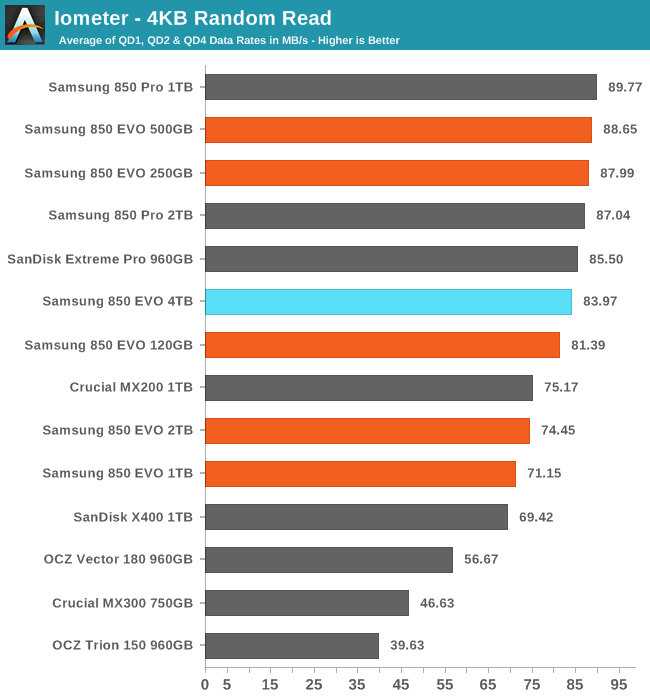
Random read performance of the 4TB 850 EVO is substantially better than the 1TB and 2TB 850 EVOs, but still not quite as fast as the best MLC drives or the 500GB and 250GB 850 EVOs.

The power consumption of the 4TB 850 EVO is slightly higher than the 2TB model, but overall the efficiency is improved over the smaller drive with the same controller but older NAND.
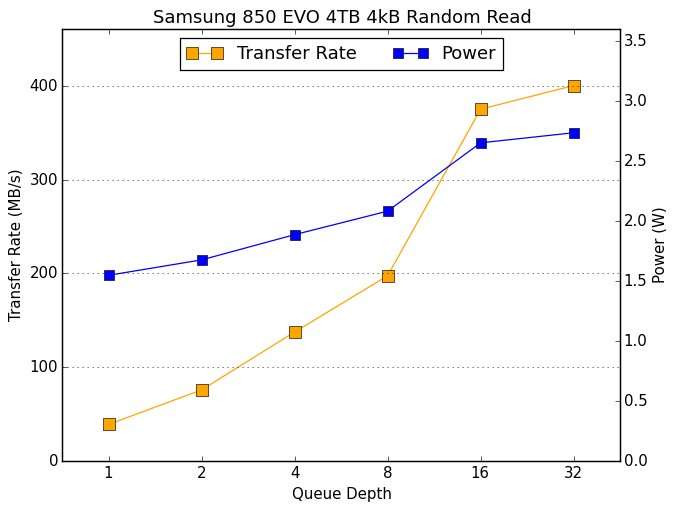 |
|||||||||
The scaling behavior of the 4TB 850 EVO is almost identical to the 2TB model, just with slightly higher performance and power consumption across the board.
Random Write Performance
The random write test writes 4kB blocks and tests queue depths ranging from 1 to 32. The queue depth is doubled every three minutes, for a total test duration of 18 minutes. The test is limited to a 16GB portion of the drive, and the drive is empty save for the 16GB test file. The primary score we report is an average of performances at queue depths 1, 2 and 4, as client usage typically consists mostly of low queue depth operations.
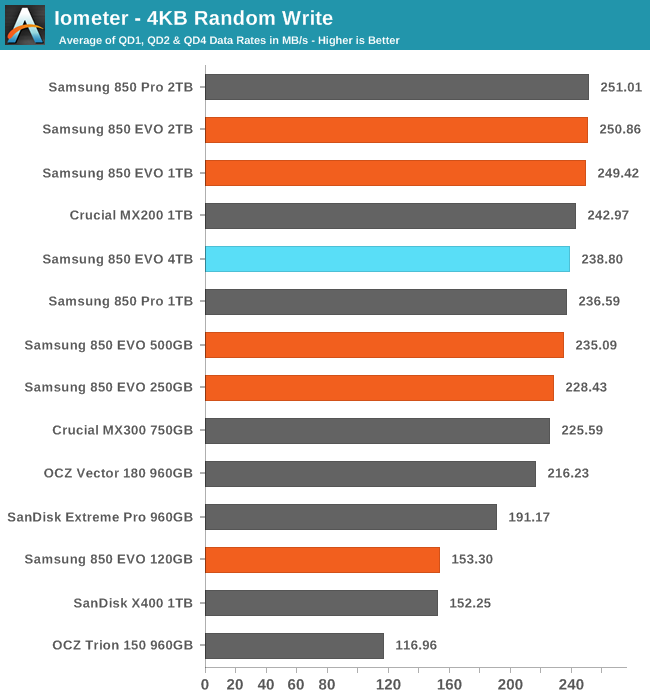
Random write speed for the 4TB 850 EVO is a little bit slower than for the 1TB and 2TB models, but still fast enough to beat almost all non-Samsung drives.
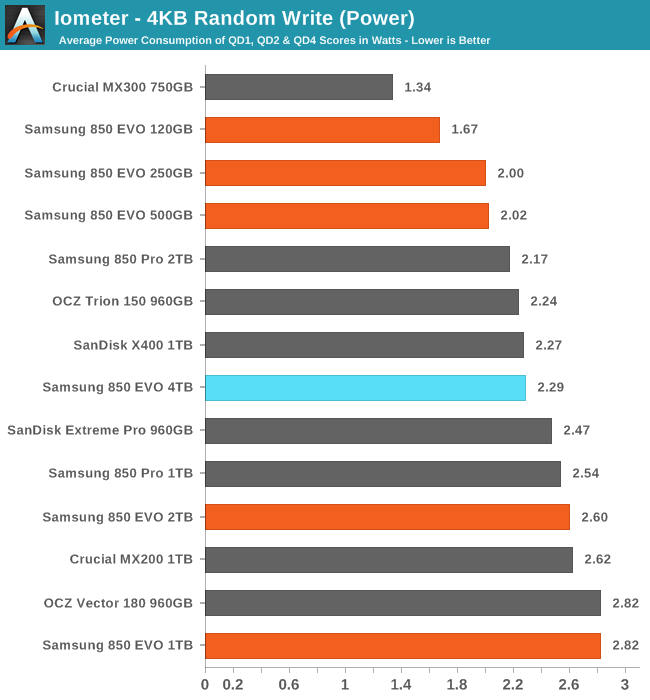
Power consumption of the 4TB 850 EVO is substantially better than the 1TB and 2TB counterparts, making it one of the most efficient large drives. The 750GB Crucial MX300 was still much more efficient.
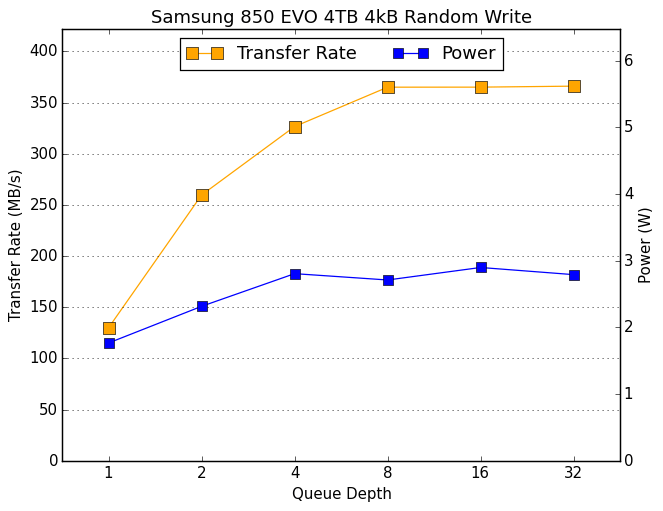 |
|||||||||
The lower performance score for the 4TB was apparently due to a regression in QD4 performance, where the 1TB and 2TB models were able to reach full speed but the 4TB needs a larger queue.










145 Comments
View All Comments
nandnandnand - Monday, July 11, 2016 - link
Weren't the first XPoint parts going to be 16-32 GB? I find $0.65/GB hard to believe... I expect $3.00/GB.nathanddrews - Monday, July 11, 2016 - link
Yeah, I'll believe it when I see it.Kevin G - Monday, July 11, 2016 - link
Where are you seeing this and for what format?I strongly suspect that Intel is going to be price competitive in the NVMe space so that's realistic but I'd expect a massive premium for Xpoint in DIMM format when Skylake-E comes around.
shabby - Monday, July 11, 2016 - link
Why would xpoint dimm be premium priced? They said its slower than dimm, so it should be cheaper.Kevin G - Monday, July 11, 2016 - link
Well what competition would the DIMM format have on SkyLake-E?SATA based SSDs are a dime a dozen and M.2 drives using NVMe are just starting to spread. What competition would Intel have with a DIMM format?
Impulses - Monday, July 11, 2016 - link
There's a lot of pie in the sky dreaming about Xpoint IMO... Why would it be priced at a premium? Same reason M.2 NVMe & PCI-E drives are, it's what the market will bear that counts. If it's any faster it'll be more expensive, simple really.ddriver - Monday, July 11, 2016 - link
Don't hold your breath. They made claims of "ram" speed, but demoed 2 GB/s hardware, which is not much faster than nvme SSDs. Ram is 20-30 GB/s...SSDs can still go a long way in terms of bandwidth - just snap more chips on more channels, given an available interface to hook it to, it would be too much trouble for the industry to create something like 8 GB/s SSD. And it only requires a better controller chip, can work with the same old flash memory chips. Currently, M2 can only provide theoretical 4 GB/s bandwidth, running at 32 gbit.
Eden-K121D - Monday, July 11, 2016 - link
a PCIe gen4 device could have potential read speeds of 8GB/sKevin G - Monday, July 11, 2016 - link
The 2 GB/s demo was using a Thunderbolt enclosure and an M.2 prototype.Full size PCIe and DIMM formats are planned so I'd consider that 2 GB demo the starting point.
benedict - Monday, July 11, 2016 - link
Horrible write endurance. If you need a drive that big you certainly have enough data to fill it 75 times.